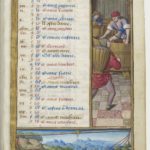
“September”, kalendar page from Les Petites Heures d’Anne de Bretagne (The Little Hours of Queen Anne of Bretagne), by the Maître des Triomphes de Pétrarque. From Bibliothèque nationale de France, Paris (France).
Two other archangels, Gabriel (who greeted Mary with the good news of her quickening) and Raphael (who stirred the water in the healing pool of Bethesda), have their own feast days, but they’re rather obscure, and so they are commemorated with Michael on the Feast of Saint Michael and All Angels. Michaelmas, at is commonly called in the Anglican church, is one of the quarter days in the English financial year, and it also marks the beginning of the fall terms in many British courts and universities.
Michael is the leader of the angelic host, despite only being an archangel, and he is the captain that leads heaven in their defeat of Lucifer. We say “despite”, because archangels are the second-lowest of the nine orders of angels. The nine orders are, from top to bottom:
- First Sphere
- Literally “burning ones”; the singular is “seraph”. Isaiah describes them as “fiery six-winged beings; with two wings that cover their faces, with another two that cover their feet, and the last two they use to fly.”
- Literally “one who blesses”; the singular is “cherub”, but these are not the putti of baroque paintings. Cherubim have four faces: one of a man, an ox, a lion, and an eagle (later adopted as the symbols of the four evangelists). They have four conjoined wings covered with eyes, a lion’s body, and the feet of oxen. Cherubim guard the way to the tree of life in the Garden of Eden.
- Thrones are depicted as great wheels containing many eyes.
- Second Sphere
- Also called “Dominions” or “Lordships”, they regulate the duties of the lower angels.
- Filled with divine strength, they work great miracles and send down the grace of miracle-working to the saints on earth; they also strengthen people with patience and humility.
- Also called “authorities”, they supervise the movements of the heavenly bodies to ensure that the cosmos remains in order. They are also warrior angels, represented as soldiers wearing full armor and helmet, and carrying shields and spears or chains.
- Third Sphere
- Also called “Princedoms” or “Rulers”, they guide and protect nations, groups of people and institutions.
- A fourth archangel, Uriel, is mentioned in the Second Book of Esdras, part of the Apocrypha. Tradition holds that there are seven archangels, although the remaining three are unnamed. They may be the seven spirits that stand before the throne of God, as described in the Book of Enoch (another book of the Apocrypha) and the Book of Revelation.
- The rank and file of the heavenly host. “Angel” comes from the Greek word for messenger or envoy, and angels appear throughout scripture with messages from God.
- Seraphim
- Cherubim
- Thrones
- Dominations
- Virtues
- Powers
- Principalities
- Archangels
- Angels
A good mnemonic for remembering the orders of angels is the first verse of Hymn 599, “Ye watchers and ye holy ones” (vigiles et sancti):
Ye watchers and ye holy ones,
Bright Seraphs, Cherubim and Thrones,
Raise the glad strain, Alleluia!
Cry out, Dominions, Princedoms, Powers,
Virtues, Archangels, Angels' choirs,
Alleluia, Alleluia, Alleluia, Alleluia, Alleluia!
You just have to remember that “Princedoms” (Principalities) and Powers are out of order, for the sake of the rhyme.
The Feast of Saint Michael and All Angels is 29 September.


